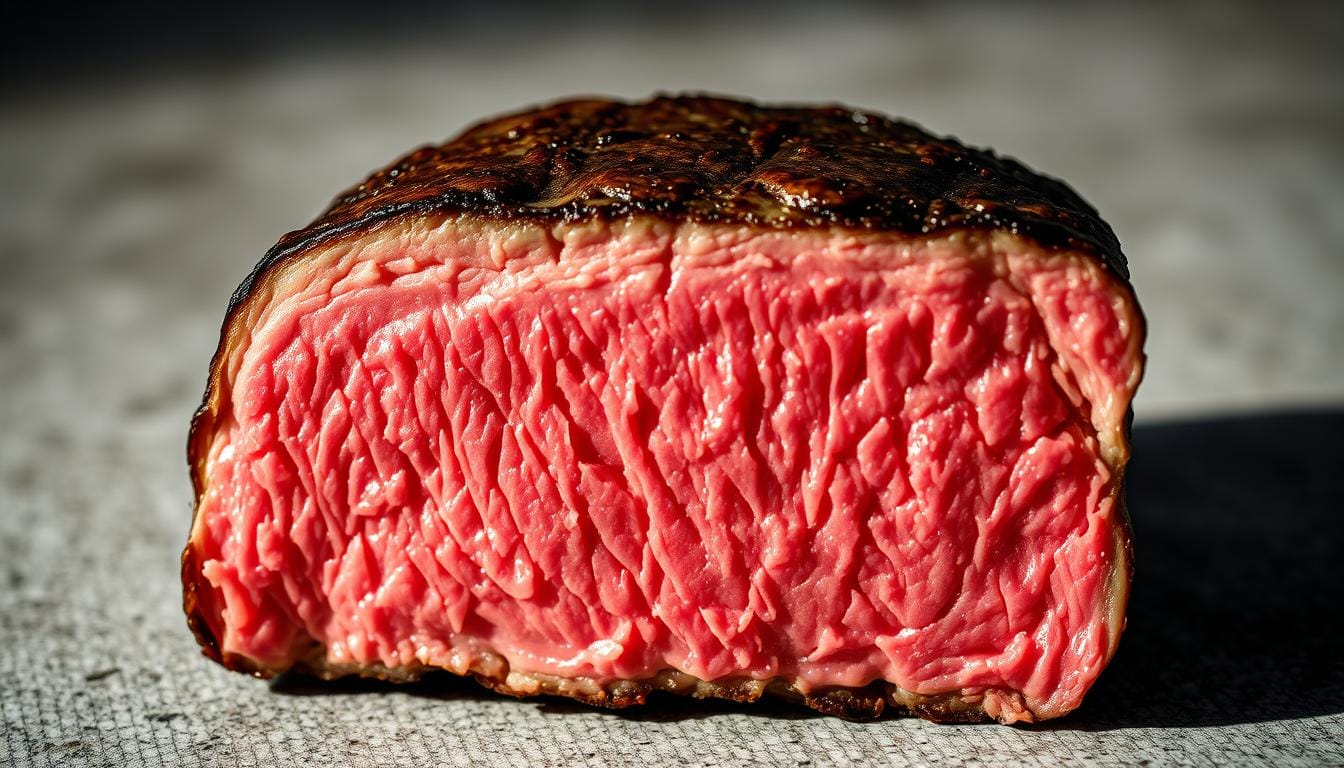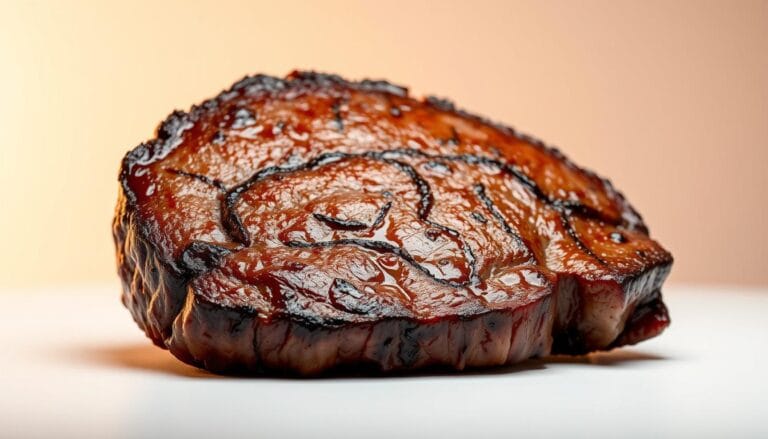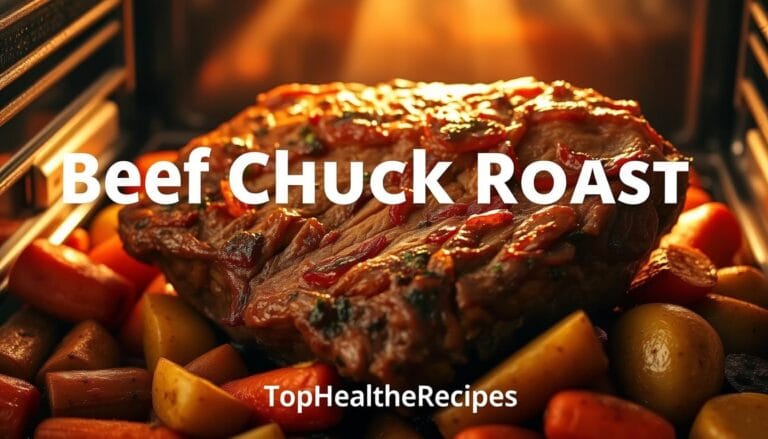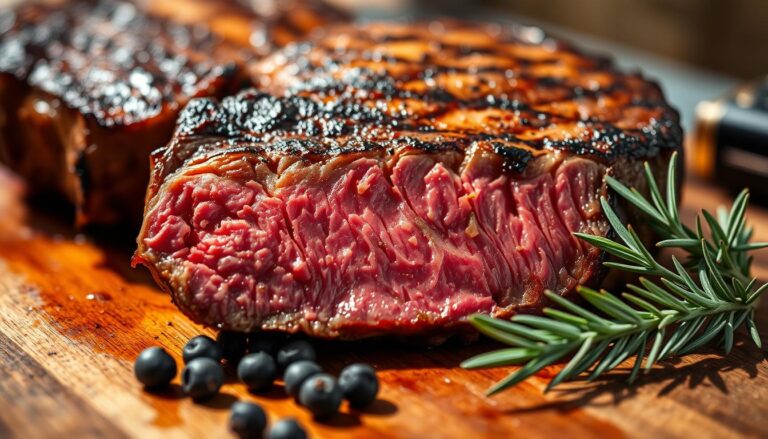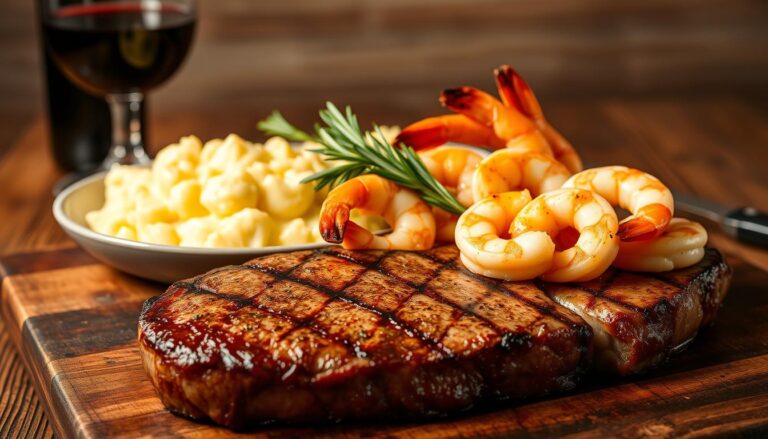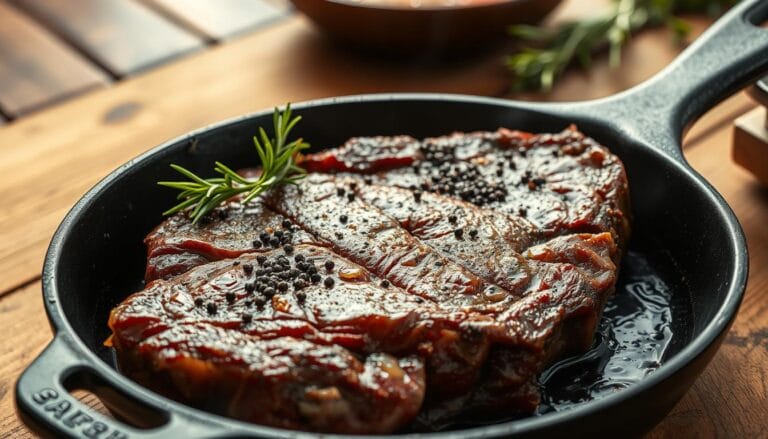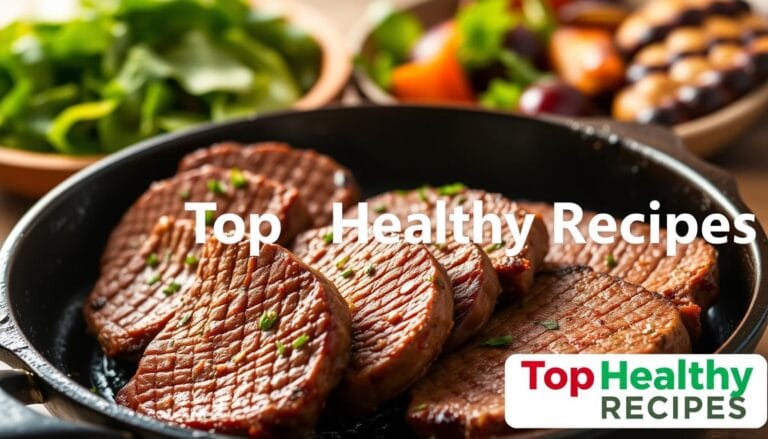Medium Steak Temperature Guide: Perfect Doneness Every Time
Table of Contents
Medium Steak Temperature Guide: Perfect Doneness Every Time
Getting the medium steak temperature right is a skill that makes your cooking stand out. It’s about knowing the exact internal temp steak that turns a simple dish into a memorable meal.
Cooking the perfect steak is a goal for many home cooks and aspiring chefs. The secret is mastering temperature control. This ensures your steak has a perfect pink center and a flavorful crust every time.
By learning the best cooking methods and temperature ranges, you can impress family and friends. You’ll be able to make restaurant-quality steaks in your own kitchen.
Key Takeaways
- Understand the ideal internal temperature for a perfectly cooked steak.
- Learn about different cooking methods to achieve the perfect doneness.
- Master temperature control to elevate your steak cooking skills.
- Discover techniques to achieve a flavorful crust on your steak.
- Impress your family and friends with restaurant-quality steak.
Understanding Steak Doneness Levels
The doneness of a steak greatly affects its taste and texture. It’s key to know the different levels. “Doneness” means how well the meat is cooked, which changes its tenderness, juiciness, and flavor.
What’s Medium Steak?
A medium steak has a warm pink center. Its outside is more cooked than a medium-rare steak, showing a gray-brown color. This doneness level is loved for its balance of tenderness and taste.
Why Doneness Matters
The doneness of a steak changes its texture and taste. Cooking it right ensures the proteins and fats are cooked just right. For a medium steak, the right internal temperature is key to a juicy center and a well-cooked outside.
Common Steak Doneness Terms
Knowing steak doneness terms is important for telling your server or when cooking at home. The main terms are:
- Rare: Cooked briefly, with a red, juicy inside.
- Medium Rare: Slightly more cooked than rare, with a warm red center.
- Medium: A mix of doneness and juiciness, with a pink center.
- Medium Well: More cooked than medium, with a hint of pink.
- Well Done: Fully cooked, with no pink left.
Understanding these terms and their temperatures helps you get your steak just right. For example, a medium steak is cooked to about 140°F to 145°F (60°C to 63°C).
The Perfect Temperature for Medium Steak
The secret to a great medium steak is knowing the perfect internal temperature. This temperature makes your steak juicy and flavorful. It’s all about getting it just right.
Ideal Internal Temperature
A medium steak should be between 135°F to 145°F (57°C to 63°C). Most chefs aim for 140°F (60°C). It’s important to take the steak off the heat at 135°F (57°C). This helps keep it juicy and tender.
Key Temperature Points:
- Minimum internal temperature for medium: 135°F (57°C)
- Optimal internal temperature: 140°F (60°C)
- Maximum internal temperature for medium: 145°F (63°C)
Cooking Temperature Guidelines
Each cooking method needs a different temperature for a perfect medium steak. Here’s what you need to know:
Grilling: Heat your grill to 400°F (204°C). Sear the steak for 3-4 minutes on each side. Then, cook it to your liking.
Pan-Searing: Heat a skillet to 375°F (190°C). Sear the steak for 2-3 minutes on each side. Then, adjust the heat to finish cooking.
Oven Broiling: Set your oven to 400°F (204°C). Broil the steak for 4-5 minutes on each side. Cook until it’s just right.
It’s key to adjust the temperature based on the steak’s thickness and cut. Thicker steaks need lower heat to avoid burning the outside before the inside is cooked.
By following these tips and knowing the ideal internal temperature, you’ll always have a perfectly cooked steak.
Different Cooking Methods for Steak
Whether you’re a seasoned grill master or a kitchen novice, understanding different cooking methods is key to a perfectly cooked medium steak. The technique you use plays a big role in achieving that ideal medium steak temperature.
Grilling Your Medium Steak
Grilling is a popular method for cooking steak, giving it a smoky flavor and a satisfying char. To grill your steak to medium doneness, use a mix of direct and indirect heat zones. Preheat your grill to high heat for searing, then move the steak to a cooler zone to finish cooking to the desired internal temperature.
Optimal Grill Temperatures:
| Cooking Stage | Temperature |
|---|---|
| Searing | High heat (around 450°F) |
| Cooking to Medium | Medium heat (around 300°F – 350°F) |
Pan-Searing Secrets
Pan-searing is another effective method for achieving a perfectly cooked medium steak. It involves searing the steak in a hot pan to create a crust, then finishing it in the oven. To pan-sear, heat a skillet over high heat, add a small amount of oil, and sear the steak for 1-2 minutes per side. Then, transfer the pan to a preheated oven to cook to the desired medium steak temperature.
Broiling for Maximum Flavor
Broiling is a great way to cook steak, giving it a nice char on the outside while keeping the inside juicy. To broil your steak, position the oven rack so that the steak is about 4 inches from the broiler. Cook for 4-6 minutes per side, or until the steak reaches your desired level of doneness. Use a thermometer to ensure it reaches the perfect beef medium well temp, which is around 150°F – 155°F for medium.
Preparing Your Steak
Getting your steak ready is key to a great medium steak. You need to focus on a few important steps before cooking.
Choosing the Right Cut
The steak you pick greatly affects the taste. For a medium steak, ribeye, strip, and filet mignon are top choices. They have the right fat and muscle for perfect doneness. A steak expert says, “The right cut makes all the difference in taste and texture.”
“A good steak is not just about the cooking, it’s about the quality of the meat you start with.”
Look for steak thickness and marbling when picking. These affect cooking time and flavor. A 1-1.5 inch thick steak is best for medium.
Seasoning Tips for Flavor
Seasoning boosts your steak’s flavor. Salt and pepper work well, but try herbs and spices for more taste. A mix of garlic powder, paprika, and thyme is tasty. Season at least 30 minutes before cooking to let flavors soak in.
For more seasoning ideas, check out shrimp on steak. It adds extra flavor to your meal.
Bringing Your Steak to Room Temperature
Letting your steak warm up before cooking is essential. It takes 30-60 minutes, depending on the steak’s thickness. This ensures even cooking for that perfect medium doneness.
Remember, “the more you prepare, the better your steak will turn out.” Follow these steps for a perfectly cooked steak.
Cooking Your Medium Steak
To cook a medium steak, focus on the right temperature. It’s not just about following steps. It’s about knowing what affects cooking.
Time vs. Temperature: What to Know
When cooking a steak, temperature is key, not time. The time needed changes with the steak’s thickness and starting temperature. A thicker steak takes longer, even with the same cooking method.
Factors Affecting Cooking Time:
- Steak thickness
- Starting temperature of the steak
- Cooking method (grilling, pan-searing, broiling)
Using a Meat Thermometer
A meat thermometer is essential for a perfect medium steak. It removes the guesswork, ensuring the steak is cooked just right. There are two main types: instant-read digital and leave-in probe thermometers.
Instant-read digital thermometers give quick temperature checks. Leave-in probe thermometers let you monitor the steak’s temperature continuously.
| Thermometer Type | Best For | Key Benefit |
|---|---|---|
| Instant-read digital | Quick checks | Fast and accurate readings |
| Leave-in probe | Continuous monitoring | Real-time temperature tracking |
Visual Indicators of Doneness
While a thermometer is best, you can also use visual signs. Look at the steak’s color, the juices, and the “touch test.”
The touch test compares the steak’s firmness to your hand. For medium, it should feel like the base of your thumb when touching your thumb to your index finger.
Resting Your Steak
After cooking your steak to the perfect medium temperature, the next step is often overlooked: resting. This step is critical. It allows the internal temperature to stabilize and the juices to spread evenly. This makes your steak more tender and flavorful.
The Importance of Resting
Resting your steak is not just waiting. It’s an active process that greatly improves your meal’s quality. When you cook a steak, the heat tightens the proteins and pushes juices to the surface. Letting it rest allows these juices to spread, making each bite more juicy.
Carryover cooking is another important factor during resting. This happens when the steak’s internal temperature keeps rising after it’s removed from heat. For a medium steak, remove it when it’s 5-10°F below your target temperature. It will continue to cook while resting.
How Long to Rest Your Steak
The resting time depends on the steak’s thickness. Most steaks need 5-10 minutes to rest. Here’s a simple guide:
- Thin steaks (less than 1 inch thick): 5 minutes
- Medium steaks (1-1.5 inches thick): 7-8 minutes
- Thick steaks (over 1.5 inches): 10 minutes or more
To rest your steak effectively, loosely cover it with foil and place it on a warm plate. This keeps the temperature steady and prevents it from cooling too fast.
By using proper resting techniques, you’ll get a more consistent internal temp steak. Whether you’re aiming for beef medium well temp or something rarer, resting is essential. It unlocks your steak’s full flavor and tenderness.
Serving Suggestions
After cooking your steak to the perfect medium, think about adding some great sides and drinks. A complete meal not only tastes good but also makes your steak dinner more enjoyable.
Best Sides for Medium Steak
Classic steakhouse sides are always a winner with medium steak. Here are some favorites:
- Roasted Potatoes: They can be crispy or fluffy, and they match the steak’s savory taste.
- Creamed Spinach: This creamy side dish is a nice contrast to the steak’s heartiness.
- Grilled Asparagus: For a lighter choice, asparagus adds a fresh, charred taste that goes well with steak.
- Mushroom Preparations: Whether sautéed or wild, mushrooms add depth to your steak’s flavor.
| Side Dish | Description | Pairing Reason |
|---|---|---|
| Roasted Potatoes | Crispy outside, fluffy inside | Savory flavor complement |
| Creamed Spinach | Rich and creamy | Balances heartiness |
| Grilled Asparagus | Fresh and slightly charred | Contrasting flavors |
Wine Pairing Tips
Choosing the right wine can make your meal better. For medium steak, medium-bodied reds are best. Here are some good picks:
- Merlot: It’s smooth and pairs well with the steak’s balanced taste.
- Zinfandel: If you like spice, Zinfandel’s bold taste goes great with the steak’s richness.
- Cabernet Sauvignon: Lighter Cabernets can enhance the steak’s flavor without being too strong.
If wine isn’t your thing, try pairing your steak with craft beers or bourbon for a different twist.
Popular Medium Steak Recipes
Cooking steak to medium doneness is an art. It requires the right recipes and techniques. Here are three premium steak recipes that show the importance of temperature control and technique.
Grilled Ribeye
A classic grilled ribeye is a favorite among steak lovers. First, preheat your grill to high heat. Season the ribeye with salt, pepper, and herbs.
Place the steak on the grill and sear for 3-4 minutes per side. Then, move it to a cooler part of the grill. Use a meat thermometer to check for an internal temperature of 140°F – 145°F.
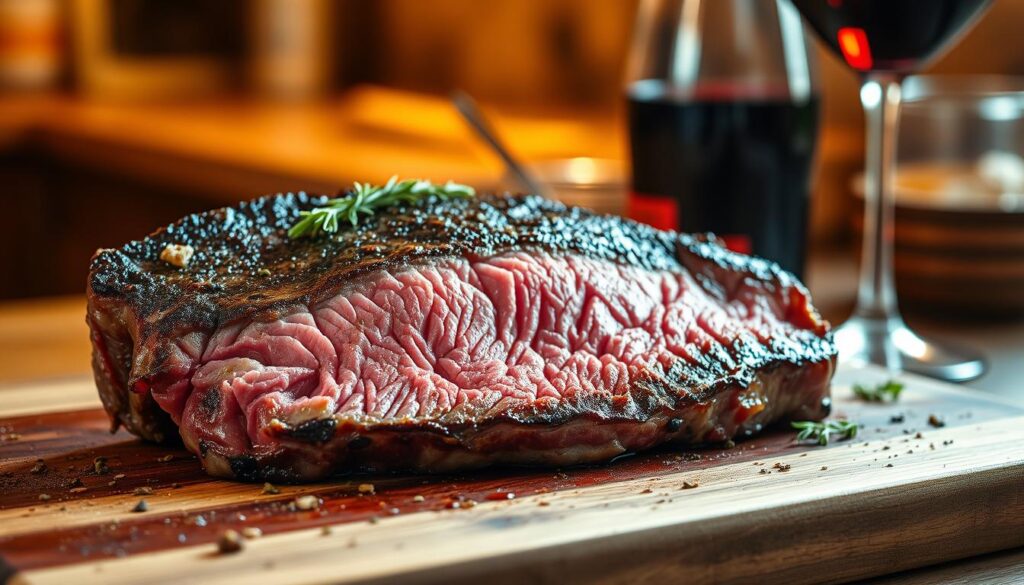
Pan-Seared New York Strip
Pan-searing gives your New York strip a flavorful crust and a tender interior. Heat a skillet over high heat and add oil. Sear the steak for 2-3 minutes per side, then reduce the heat to medium.
Continue cooking until it reaches your desired doneness. Baste the steak with butter during the last few minutes for extra flavor. The internal temp steak for medium doneness should be between 140°F and 145°F.
Broiled Filet Mignon
Broiling is great for cooking filet mignon to medium doneness without drying it out. Preheat your broiler and position the rack about 4-5 inches from the heat source. Season the filet mignon with salt, pepper, and seasonings.
Broil the steak for 4-5 minutes per side, or until it reaches an internal temp steak of 140°F – 145°F. Let the steak rest for a few minutes before serving to allow the juices to redistribute.
By following these recipes and paying close attention to the medium steak temperature, you can achieve perfectly cooked steak every time. Whether you prefer grilled, pan-seared, or broiled steak, the key is to cook it to the right temperature and let it rest before serving.
Troubleshooting Common Issues
Cooking the perfect medium steak can be tricky. Knowing how to fix common problems can save the day. Whether it’s an undercooked steak, an overcooked one, or adjusting for environmental factors, understanding these challenges is key.
Undercooked Steak: What to Do
If your steak is undercooked, don’t panic. There are safe ways to keep cooking it without losing quality. Finishing the steak in a low-temperature oven is one effective method. It ensures even cooking and prevents overcooking the outside.
Another approach is the “reverse sear” rescue technique. First, cook the steak in a low-temperature oven. Then, sear it in a hot pan. This method can help achieve a perfectly cooked medium steak.
- Preheat your oven to 275°F (135°C).
- Cook the steak to the desired internal temperature (around 140°F or 60°C for medium).
- Sear the steak in a hot pan with oil to achieve a nice crust.
Overcooked Steak: Creative Solutions
Sometimes, a steak ends up overcooked despite our best efforts. But, there are creative ways to save it. Slicing the steak thinly against the grain can make it more tender and palatable. Adding a rich sauce can also mask any dryness and enhance flavor.
Tips for salvaging overcooked steak:
- Slice it thinly against the grain.
- Use it in salads or sandwiches.
- Add a flavorful sauce to mask dryness.
Adjusting for Altitude and Cooking Variations
Cooking steak at high altitudes or with different equipment can affect the outcome. At high altitudes, water boils at a lower temperature, which can impact cooking times. Adjusting your cooking technique, such as using a thermometer to ensure the steak reaches the correct internal temperature (around 140°F or 60°C for medium), is key.
Also, variations in steak thickness and fat content can influence cooking times. It’s essential to be flexible and adjust your cooking method as needed.
For a beef medium well temp, you’re looking at an internal temperature of around 150°F (65°C). Understanding these nuances and being prepared to adjust can help you achieve a perfectly cooked medium steak, even under challenging conditions.
When cooking steak, it’s also worth noting that the ideal temperature for a medium rare steak is around 130°F to 135°F (54°C to 57°C). Being aware of these temperatures and how to adjust for different conditions can elevate your steak-cooking game.
Storage and Leftovers
After enjoying your perfectly cooked medium steak, it’s key to store leftovers right. This keeps food safe and flavorful. The right storage and reheating can greatly improve your leftover steak’s quality.
Properly Storing Cooked Steak
To store cooked steak, cool it down fast to a safe temperature. Use shallow containers to cool it faster and more evenly. Once cooled, cover it with plastic wrap or aluminum foil and refrigerate at 40°F (4°C) or below. Cooked steak stays safe in the fridge for 3 to 4 days.
Culinary experts say, “Cooling cooked steak quickly stops bacterial growth.”
“The key to keeping leftover steak fresh is to chill it rapidly and store it in airtight containers.”
Reheating Steak Without Drying It Out
Reheating steak without drying it out needs careful attention. Use a low-temperature oven, about 250°F (120°C), to warm it gently. You can also add moisture by covering it with foil and placing it on a rimmed baking sheet with a bit of beef broth or water.
For precise reheating, try a sous vide machine. This method heats the steak evenly, keeping it at your preferred doneness. For medium steak, reheat to about 140°F (60°C).
Another way is to quickly sear the steak in a hot pan after gentle reheating. This method refreshes the outside while keeping the inside juicy. Always check the internal temperature to avoid overcooking, aiming to keep it at or below the initial cooking temperature.
Health and Safety Tips
Cooking a steak to medium doneness is more than just about temperature. It’s also about safety. Making sure your steak is cooked safely is key to enjoying your meal without health worries.
Safe Cooking Temperatures
The USDA says to cook whole muscle cuts like steaks to at least 145°F (63°C) for medium doneness. Then, let them rest for 3 minutes. This makes sure your steak is tasty and safe to eat. For medium well, aim for 150°F to 155°F (66°C to 68°C).
Key Temperature Guidelines:
- Medium Rare: 130°F – 135°F (54°C – 57°C)
- Medium: 140°F – 145°F (60°C – 63°C)
- Medium Well: 150°F – 155°F (66°C – 68°C)
Avoiding Cross-Contamination
Handling raw meat can lead to cross-contamination. To avoid it, keep raw steaks separate from cooked and ready-to-eat foods. Use different cutting boards, plates, and utensils for raw meat to stop bacteria like Salmonella and E. coli from spreading.
Best Practices to Prevent Cross-Contamination:
- Wash your hands well before and after touching raw meat.
- Clean all surfaces and tools that touch raw meat.
- Store raw meat in sealed containers to stop juices from leaking onto other foods.
People at higher risk of foodborne illness, like pregnant women, the elderly, and those with weak immune systems, should cook steak to well-done. This helps lower the risk.
Choosing Quality Steak
Getting a perfectly cooked medium steak starts with picking the right cut of meat. The quality of your steak is key to getting the perfect medium doneness. It affects both taste and texture.
Understanding Grade and Quality
The USDA grading system is important for steak quality. It ranges from Prime to Select, with Prime being the highest. Prime steaks have lots of marbling, which makes them taste better and be more tender.
USDA Grading System:
| Grade | Description | Marbling Level |
|---|---|---|
| Prime | Highest quality with abundant marbling | Abundant |
| Choice | High quality with moderate marbling | Moderate |
| Select | Leaner with less marbling | Less |
Marbling, or the fat inside the meat, is key for juiciness and flavor. For a medium steak, you want a good amount of marbling. It keeps the steak moist and tender.
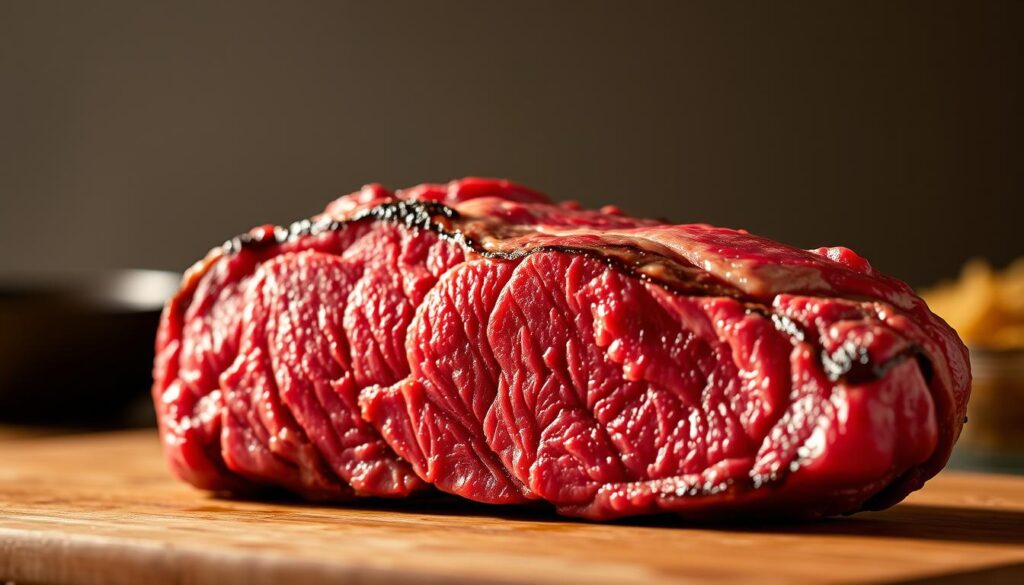
Recommendations for Local Butchers
Working with your local butcher can make cooking steak better. They can tell you the best cuts for medium doneness. They also know about aging methods and special cuts not found in supermarkets.
When you visit your local butcher, ask these questions:
- What are the sourcing practices for your meat?
- Can you recommend cuts that are ideal for cooking to medium temperature?
- What aging methods do you use, and how do they impact the flavor and tenderness of the steak?
Knowing about steak grade and quality and talking to local butchers can help you get the perfect medium steak.
The Role of Marinades
Marinades are key to making steaks taste better and feel softer, even when cooked to medium. The right mix of ingredients can make your meal much better.
Marinading for Flavor and Tenderness
Marinating is great for tougher, cheaper steaks. The acid in marinades, like vinegar or citrus, breaks down proteins. This makes the steak softer. Oils and other flavors add depth and complexity.
Key Components of a Marinade:
- Acidic ingredients (vinegar, citrus juice)
- Oils (olive, avocado)
- Flavor enhancers (garlic, herbs, spices)
Popular Marinade Ingredients
There are many things you can put in a marinade. Garlic, thyme, rosemary, and black pepper are favorites. For an Asian twist, try soy sauce and ginger. Bourbon-based marinades add a rich, complex flavor.
Marinade Timing Considerations: Finding the right marinating time is important. Too short, and the steak won’t get enough flavor. Too long, and it can become too soft. A few hours to overnight is usually best.
To get a perfect medium steak, watch the internal temperature closely. The ideal is between 140°F and 145°F (60°C to 63°C). A meat thermometer helps you hit this mark without overcooking.
Learning about marinades can improve your steak-cooking skills. With the right marinade, you can make a medium steak that’s both flavorful and tender every time.
Steak Cooking Equipment
To get a perfect medium steak, you need the right tools. Having the right kitchen equipment is key to cooking your steak just right every time.
Essential Tools You’ll Need
First, you’ll need some basic tools for a perfectly cooked medium steak. These include:
- Reliable Meat Thermometers: Instant-read digital thermometers and leave-in probe thermometers are key for checking your steak’s internal temperature.
- Heavy-Duty Pans: Cast iron pans are great for searing steaks. They work well on the stovetop or in the oven.
- Quality Tongs: Tongs are handy for flipping steaks and handling them while cooking.
- Sharp Knives: A sharp knife is necessary for cutting your steak properly after it’s cooked.
- Proper Cutting Boards: A good cutting board is essential for slicing your steak.
Upgrading Your Kitchen Gear
If you’re serious about steak cooking, there are better tools to consider. These include:
| Equipment | Benefit | Example |
|---|---|---|
| Sous Vide Circulators | Precise temperature control for consistent results | Anova Sous Vide |
| Infrared Thermometers | Accurate surface temperature readings | Thermapen Infrared |
| High-End Grills | Temperature zones for different cooking techniques | Weber Summit Grill |
| Aging Equipment | Allows for dry-aging steaks at home for enhanced flavor | Umami Dry-Aging Fridge |
Investing in these tools can greatly enhance your steak cooking. They offer more precise control and can lead to better-tasting steaks.
FAQs About Medium Steak Temperature
Many people wonder about the best way to cook a medium steak. They ask about temperature control and cooking techniques. We’ll answer some common questions to help you cook the perfect medium steak.
What Happens if You Cook Steak Incorrectly?
Cooking steak wrong can ruin your meal. Overcooking makes it dry and tough. Undercooking can make it unsafe and unpleasant.
If you overcook, try slicing it thinly and adding sauce. For undercooked steak, cook it more but watch out for overcooking.
Can You Cook Frozen Steak?
Yes, you can cook frozen steak, but it needs special care. It cooks unevenly, with the outside getting too hot. Start by searing it, then cook it more slowly.
Use a meat thermometer to check the temperature. Cooking frozen steak takes longer than thawed steak.
Additional FAQs
People often ask about the difference between medium and medium-rare. Medium is 140°F – 145°F (60°C – 63°C). Medium-rare is 130°F – 135°F (54°C – 57°C).
“How do different steak cuts respond to medium cooking?” Different cuts vary in tenderness and fat, affecting cooking.
“Should you oil the steak or the pan?” You can do either. Oiling the pan helps prevent sticking.
“How do you adjust cooking for different steak thicknesses?” Thicker steaks need longer cooking times and lower heat to avoid burning.
Conclusion
Cooking a medium steak to perfection requires knowing the right internal temperature and using precise cooking methods. The ideal temperature for a medium steak is between 135-145°F (57-63°C). It’s best to remove the steak from heat at about 135°F to allow for carryover cooking.
Key Takeaways for Perfect Doneness
To cook a medium steak just right, start by letting it come to room temperature. Use a meat thermometer to check the internal temperature. Also, master your cooking method and let the steak rest properly. These steps will help you get a delicious result every time.
Practicing to Perfection
Begin with easier cuts and move to more expensive ones as you get better. Keeping a cooking journal can help you track your progress. Joining online steak communities or taking cooking classes can also improve your skills. With these tips, you’ll get the perfect medium steak temperature every time.
FAQ
What is the ideal internal temperature for a medium steak?
What happens if you cook steak to the wrong temperature?
Can you cook frozen steak to medium temperature?
What’s the difference between medium and medium-rare steak temperature?
How do different steak cuts respond to medium cooking?
Should you oil the steak or the pan when cooking?
How do you adjust cooking for different steak thicknesses?
What is the best way to reheat steak without drying it out?
How long should you rest your steak after cooking?
What are some common issues when cooking steak to medium temperature, and how can you troubleshoot them?
For more cooking tips, stay connected with us. We also recommend the cookbook Skinnytaste Simple: Easy, Healthy Recipes with 7 Ingredients or Fewer
For more Recipes about Steak ?
Did You try our recipe ?
There are no reviews yet. Be the first one to write one.
